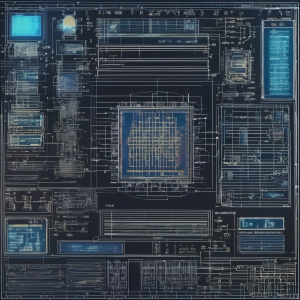 By KEN KORCZAK
By KEN KORCZAK
What if someone created a digital avatar of you and placed it in a massive simulation database –- and you knew nothing about it?
How would you feel about that?
Yes, while you are blissfully ignorant and unaware and just going about your normal life, your “simulated self” is now also going about its own life in a simulated global environment with most of the other eight billion other people inside a simulated planet Earth.
Well, what if I told you this has already happened?
It has!
The server for this world simulation database –- that includes your avatar -– is actually located in (drumroll): Indiana! That’s right! It’s called the Sentient World Simulation (SWS). It is up and running and is housed in a building at Purdue University, West Lafayette, Indiana.
The SWS is the brainchild of Dr. Alok R. Chaturvedi, a professor of information systems who is also the founder and director of the SEAS Laboratory at Purdue’s Krannert School of Management.
SEAS stands for Synthetic Environment and Analysis Simulations. Dr. Chaturvedi outlined his concept for the SWS in a 2006 academic paper titled:
Sentient World Simulation: A Continuously Running Model of the Real World: A Concept Paper
From the abstract of this document, the concept is explained this way:
“The goal of the Sentient World Simulation (SWS) is to build a synthetic mirror of the real world with automated continuous calibration with respect to current real-world information, such as major events, opinion polls, demographic statistics, economic reports, and shifts in trends.”
I should add that the “geography” of an area is modeled at multiple levels, including city, state, country, selected regions of interest and, of course, globally. Some categories for models include military, political, social, economic, informational and infrastructure nodes.
After publishing his 2006 concept paper, it didn’t take long for the thing to get up and running. By 2007, the SWS had already collected massive amounts of data in 62 of the 195 nations on Earth.
It is important to point out that the SWS is a project that was initiated by the U.S. Joint Forces Command.
Some believe, as does noted futurist Rebecca Hardcastle Wright Ph.D., that SWS has since advanced well beyond 62 countries in the 15 years since 2007 to now encompass most areas of the planet that matter and has swept up the majority of Earth’s 8-billion-person population.
IT’S NOT QUITE ‘THE MATRIX’ YET BUT …
Now let me clarify that your avatar in the SWS is not (probably not yet) a complete duplicate of yourself in terms of image or looks, and it does not possess self-aware consciousness as did Neo and his pals in the Matrix.
It is significant to note that the SWS team at Purdue maintains that they “do not create your identical likeness” and instead used a “depersonalized likeness.” They also say this depersonalized likeness is “not immediately identifiable” and “cannot be replicated.”

Even so, many may find it equally disturbing that each avatar in the SWS virtual reality universe does represent a thorough activity profile of who you are and what you are doing in the real world.
That’s because you are likely “feeding” your avatar every day whether you know it or not.
You do that by participating in the digital world. Every time you engage with cyberspace, the SWS vacuums up that data point and adds it to the profile of your avatar.
For example, when you make a purchase on Amazon, search for something on Google, do your taxes online, text a friend, pay a utility bill, use a debit card to pay for a meal at a restaurant –- that information is funneled to the SWS and your avatar is updated to reflect your ongoing lifestyle.
This creates a “predictive model” of you and tells SWS operators how you are likely to react in certain situations as well as how you will perform or act in a group dynamic situation.
WHY WAS THE SENTIENT WORLD SIMULATION BUILT?
Well …
Remember when former NSA computer consultant Edward Snowden went rogue in 2013 and fled to Hong Kong and then to the Russian Federation along with a treasure trove of highly classified intelligence files on the NSA’s massive global surveillance program?
This surveillance program involved mostly tapping and monitoring millions, if not billions of telephones and internet communication accounts. The overt rationale for the creation of this program was for counterterrorism.
Ostensibly, the NSA wanted to be able to identify terrorist chatter across the telecom and cybernetwork bandwidth as a way to identify and thwart possible major attacks against American interests.

Snowden bolted because of the NSA’s ability to tap and monitor private citizens and everyday innocent Americans a fundamental violation of privacy, unconstitutional and the start of a bona fide “Big Brother” nightmare state.
Well, one might consider the SWS the next logical step. It is the NSA wiretap effort on steroids.
With this new system, the information gathering on all citizens of the world can go well beyond listening in on their phone chatter, texting or email communications.
Rather, it collects a wide range of data points that essentially provide a complete profile of every person, including what they do, what they like, how they act in certain situations, and so on.
When all this information is dumped into one massive database –- in this case, an actual simulation program –- you not only have real-time data on every individual in every nation on earth -– you also now can massage the data in myriad useful ways.
That includes running gaming simulations on how vast populations will react to specific situations.
For example, let’s say the U.S. Department of Defense (DoD) would like to know how the population of the East Coast would react if they knew an enemy had released a deadly virus into the subway system of New York City.
The DoD folks would be eager to “game the scenario” of a bioweapons attack before it happened to that they, in turn, could formulate an effective response by knowing with a high degree of certainty how large populations of people would react.
As Dr. Chaturvedi writes in his concept paper:
“The ability of a synthetic model of the real world to sense, adapt, and react to real events distinguishes SWS from the traditional approach of constructing a simulation to illustrate a phenomenon. Behaviors emerge in the SWS mirror world and are observed much as they are observed in the real world.”
WHO USES SWS DATA?
As you might expect, the SWS has no lack of eager clients consisting of powerful government agencies, private entities and Fortune 500 companies. A short (and by far not exhaustive) list includes:
- The U.S. Department of Defense
- The U.S. Department of Justice
- Eli Lilly
- Lockheed Martin
- The U.S. Department of Homeland Security
Furthermore, SWS has found customers in everything from banks and financial institutions that use it to test psyop events — to Hollywood studios who want to “game out” audience reactions to proposed movie scripts and ideas.
The above is according to Hardcastle Wright in her book 2021 book, Exoconscious Humans. She also said the SWS was used to simulate a cough spreading inside an airplane during the height of COVID. (Exoconscious Humans, Page 160).

IS THERE PUBLIC OUTRAGE?
There is some, but as far as I can tell, those sounding an alarm about the intrusiveness of the SWS are few and far between.
One person who is disturbed by the existence of the SWS is software specialist and cryptocurrency advocate Alireza Beikverdi. He wrote in a 2015 article for Cointelegraph.com:
“The project is dangerous and intrusive enough that one of its researchers even quit, citing concerns about the possibility of handing over such a dangerous weapon to a top-secret agency with little accountability.” (Source)
Beikverdi added:
“This not only invades our privacy but can also cause severe damage to society. Knowing that there is a copy of each of us in the virtual world, which can think and behave like us, and whose actions can be predicted by the authorities is a far more intimidating invasion. This will have a negative impact on societies by reducing trust between citizens and government, as well as among people — altering normal human behavior since the populace will be conscious of the fact that there is a copy of them in a virtual world without their consent.” (Source)
Others grumble about the SWS but also express a sense of inevitability. One example is the commentators over at the Everywhere You Go is Bullsh*t webcast. In this video, they state:
“As our lives move online, this (the SWS) is an inevitable part of that. We all want that feeling of safety and this kind of thing provides … and we allowed this to happen. I think as more people become aware that this is the reality of this intense kind of privacy breach is happening, I think eventually we are going to accept it and it is going to get worse — or there will be some kind of rebellion about it and it’s going to be a pretty interesting future.”
ONLY SCRATCHING THE SURFACE
Certainly, the existence of the Sentient World Simulation project at Purdue University has profound implications in and of itself. However, in conducting research for this story, I quickly found myself drawn into a much deeper and more complex rabbit hole.
When you place the SWS into context with other current facets driving other kinds of technological determinism — such as the race toward fully self-conscious AI, the cybernetic manipulation/transformation of the human body and the transhumanism movement writ large — it becomes apparent that SWS is but one aspect of a rapidly evolving human sphere of fundamental transformations.
Thus, even if you loathe the idea of the SWS and want to implement social and/or political efforts to slow it down or kill it — you’ll be up against an array of technological/social initiatives of profound scope, character, variety and purpose.
Can anyone stop it, or even opt out? That won’t be easy.
ADDITIONAL NOTE:
 For further reading about broader issues of “the Surveillance State” and how it dovetails with the overarching issue of transhumanism, AI and the technological determinism that will shape our future, I recommend: Exoconscious Humans: Will Free Will Survive in an Increasingly Non-Human World? by Rebecca Hardcastle Wright, Ph.D.
For further reading about broader issues of “the Surveillance State” and how it dovetails with the overarching issue of transhumanism, AI and the technological determinism that will shape our future, I recommend: Exoconscious Humans: Will Free Will Survive in an Increasingly Non-Human World? by Rebecca Hardcastle Wright, Ph.D.
NOTE: For more stories like this and other topics, please visit: KEN-ON-MEDIUM
